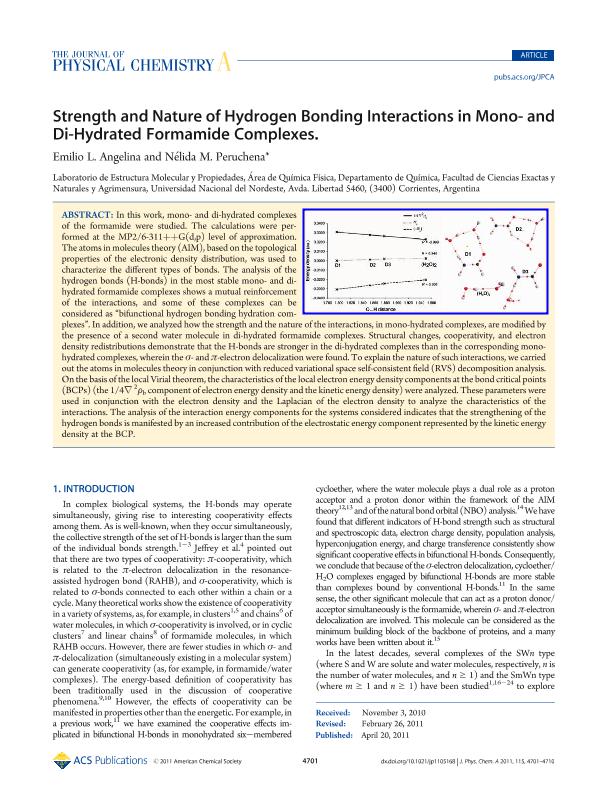Artículo
Strength and nature of hydrogen bonding interactions in mono- and di-hydrated formamide complexes
Fecha de publicación:
04/2011
Editorial:
American Chemical Society
Revista:
Journal of Physical Chemistry A
ISSN:
1089-5639
Idioma:
Inglés
Tipo de recurso:
Artículo publicado
Clasificación temática:
Resumen
In this work, mono- and di-hydrated complexes of the formamide were studied. The calculations were performed at the MP2/6-311++G(d,p) level of approximation. The atoms in molecules theory (AIM), based on the topological properties of the electronic density distribution, was used to characterize the different types of bonds. The analysis of the hydrogen bonds (H-bonds) in the most stable mono- and di-hydrated formamide complexes shows a mutual reinforcement of the interactions, and some of these complexes can be considered as “bifunctional hydrogen bonding hydration complexes”. In addition, we analyzed how the strength and the nature of the interactions, in mono-hydrated complexes, are modified by the presence of a second water molecule in di-hydrated formamide complexes. Structural changes, cooperativity, and electron density redistributions demonstrate that the H-bonds are stronger in the di-hydrated complexes than in the corresponding mono-hydrated complexes, wherein the σ- and π-electron delocalization were found. To explain the nature of such interactions, we carried out the atoms in molecules theory in conjunction with reduced variational space self-consistent field (RVS) decomposition analysis. On the basis of the local Virial theorem, the characteristics of the local electron energy density components at the bond critical points (BCPs) (the 1/4∇ 2ρb component of electron energy density and the kinetic energy density) were analyzed. These parameters were used in conjunction with the electron density and the Laplacian of the electron density to analyze the characteristics of the interactions. The analysis of the interaction energy components for the systems considered indicates that the strengthening of the hydrogen bonds is manifested by an increased contribution of the electrostatic energy component represented by the kinetic energy density at the BCP.
Palabras clave:
Charge Density
,
Formamide
,
Rvs
,
Electronic Energy Density
,
Hydrogen Bonds
,
Aim
Archivos asociados
Licencia
Identificadores
Colecciones
Articulos(CCT - NORDESTE)
Articulos de CTRO.CIENTIFICO TECNOL.CONICET - NORDESTE
Articulos de CTRO.CIENTIFICO TECNOL.CONICET - NORDESTE
Articulos(IMIBIO-SL)
Articulos de INST. MULTIDICIPLINARIO DE INV. BIO. DE SAN LUIS
Articulos de INST. MULTIDICIPLINARIO DE INV. BIO. DE SAN LUIS
Citación
Angelina, Emilio Luis; Peruchena, Nelida Maria; Strength and nature of hydrogen bonding interactions in mono- and di-hydrated formamide complexes; American Chemical Society; Journal of Physical Chemistry A; 115; 18; 4-2011; 4701-4710
Compartir
Altmétricas




